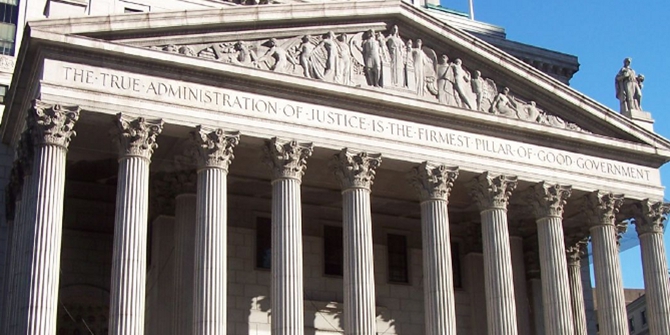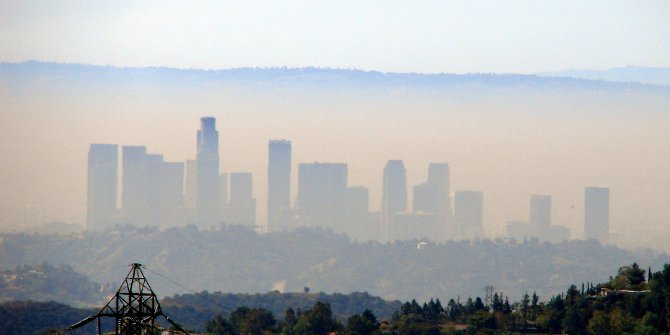
 For over 150 years, Chinatowns have played an important role in large US cities. But, with increasing gentrification and urban change, Chinatowns are changing. In new research focusing on Chinatowns in Boston and Philadelphia, Arthur Acolin and Domenic Vitiello find that while the number of Asian residents has fallen, the share of Asian ownership has risen.
For over 150 years, Chinatowns have played an important role in large US cities. But, with increasing gentrification and urban change, Chinatowns are changing. In new research focusing on Chinatowns in Boston and Philadelphia, Arthur Acolin and Domenic Vitiello find that while the number of Asian residents has fallen, the share of Asian ownership has risen.
Ethnic neighborhoods have important economic, social and cultural functions for the immigrant communities that form them and for their descendants. These neighborhoods are vital parts of American cities with restaurants, retail and cultural spaces that are used by people from the entire city and area. The fortunes of ethnic neighborhoods evolve with changes in migration; with some fading away as other emerge, oftentimes succeeding previous groups. Property ownership largely determines the course of this process of neighborhood change and preservation.
Chinatowns have historically formed in cities around the world in response to discriminatory forces. Despite repeated redevelopment threats that displaced or reduced a number of Chinatowns, many North American Chinatowns remain vibrant ethnic enclaves that continue to provide shelter and work opportunities for recent working class immigrants. Chinatowns also continue to provide social and cultural resources for immigrants from China and Asian countries more broadly, and for their descendants, whether they reside in these neighborhoods or not. Restaurants, shops, and festivals in Chinatown also attract non-Asian residents from the rest of the metropolitan region as well as tourists.
Throughout North America, the survival of Chinatowns is in question, due to changes in migration and to gentrification. As an increasing share of Chinese immigrants and their descendants move to or settle in the suburbs, and as historic Chinatowns’ locations close to revitalizing downtowns attract growing investments, the future of these enclaves is now being shaped by various, often divergent, forces.
Two Chinatowns
In our recent work we document recent changes in demographics, land use and property ownership in two historic East Coast United States Chinatowns: Boston and Philadelphia. These neighborhoods remain residential, commercial and cultural centers that share substantial similarities in terms of history, size, location within their respective cities, and the redevelopment pressures they are experiencing.
Scholars have characterized gentrifying neighborhoods in terms of demographic change, increasing property values and changes in retail. Our study focuses on another critical dimension that influences neighborhood changes: property ownership structure. Owners are important actors in determining what happens with their properties. We document changes in characteristics such as owners’ ethnicity, off-site owners, individual or corporate owners.
In our analysis, we used a mix of census, land use survey and administrative property data. Combining these different sources allows us to capture not only changes in the sociodemographic characteristics of these neighborhoods as measured by the census but also land use and property ownership. This makes it possible to examine whether trends pointing to gentrification and a decreasing Asian share of residents are mirrored by changes in the ownership structure and land use.
“Boston Chinatown – HDR – 2014-11-20 0851_2_3_4_5” by Bill Damon is licensed under CC BY 2.0
While the two neighborhoods have experienced substantial population growth and are home to a growing number of Asian residents, growth rates have been slower for Asian residents than whites. As a result, both Chinatowns went from being majority Asian in 2000 to Asian residents being a minority in 2010. The share of Asian residents declined from 64 to 45 percent in Boston and from 54 to 41 percent in Philadelphia. These trends raise questions about the future of these neighborhoods as ethnic enclaves.
The increase in population experienced by these two neighborhoods has been accompanied by an influx of higher income residents and increasing house prices and rents, despite persistent and high levels of poverty. Data from the land use survey reflect the dual nature of the two Chinatowns as mixed-use neighborhoods with predominantly lower income residents that are seeing an influx of higher income residents who are less likely to be Asian. The surveys identified a wide number of small scale commercial uses (restaurants, grocery stores, and professional services) rather than chain stores. Tenement type housing persists, but also loft condominiums have been developed in former industrial buildings and new residential buildings have gone up, both of which serve a different demographic.
Greater Asian ownership
Significantly, property ownership trends in both Chinatowns run counter to neighborhood demographic trends. In both neighborhoods, not only in the number but also the share of Asian owners has grown, although they still represent a smaller share of owners than of residents. In Boston the share of owners with Asian names increased from 20 to 23 percent between 2003 and 2013, while it increased from 23 to 37 percent in Philadelphia. These increases are particularly notable because they took place in the context of a large increase in the overall number of owners as a result of the new condominiums, which are less likely to have Asian owners. We also find a decrease in the share of off-site owners (investors or owners of commercial properties) in both neighborhoods, although they remain the majority and many of them do not live in these Chinatowns. At the same time, while the number and share of corporate owners (Trusts, LLC, LP, …) increased substantially in Boston’s Chinatown, in Philadelphia the number of properties with corporate ownership remained stable and the share of properties they control declined.
These changes in ownership structure point to the need to look beyond residents when analyzing neighborhood change, as decisions about the future use of individual properties can be made by individuals that do not live in these Chinatowns even if they have their business there or have lived there previously. Our findings indicate that while both neighborhoods have long faced redevelopment pressures, they are now experiencing changes in residents and ownership structures that simultaneously reinforce and complicate debates about gentrification and longstanding efforts to preserve these ethnic enclaves. These changes create tensions about what it means to preserve their functions as ethnic enclaves and what forms Chinatowns should take. Actions by community institutions, individual owners and residents, as well as local policies will decide the fates of these neighborhoods and what it means to preserve these and other downtown Chinatowns.
- This article is based on the paper, ‘Who owns Chinatown: Neighbourhood preservation and change in Boston and Philadelphia’, in Urban Studies.
Please read our comments policy before commenting.
Note: This article gives the views of the author, and not the position of USAPP– American Politics and Policy, nor of the London School of Economics.
Shortened URL for this post: http://bit.ly/2kLVKYw
_________________________________
About the authors
 Arthur Acolin – University of Washington
Arthur Acolin – University of Washington
Arthur Acoca Acolin is an Assistant Professor of Real Estate at the University of Washington with a broad interest in housing economics and a focus on international housing policy and finance.
 Domenic Vitiello – University of Pennsylvania
Domenic Vitiello – University of Pennsylvania
Domenic Vitiello is an Associate Professor of City Planning and Urban Studies at the University of Pennsylvania. His research on immigration compares civil society and community development in diverse newcomer and receiving communities.







